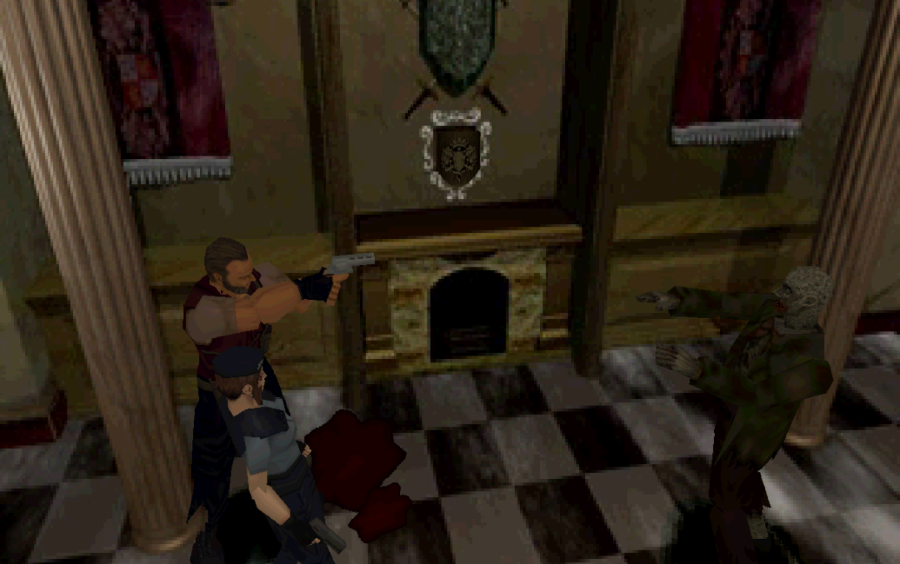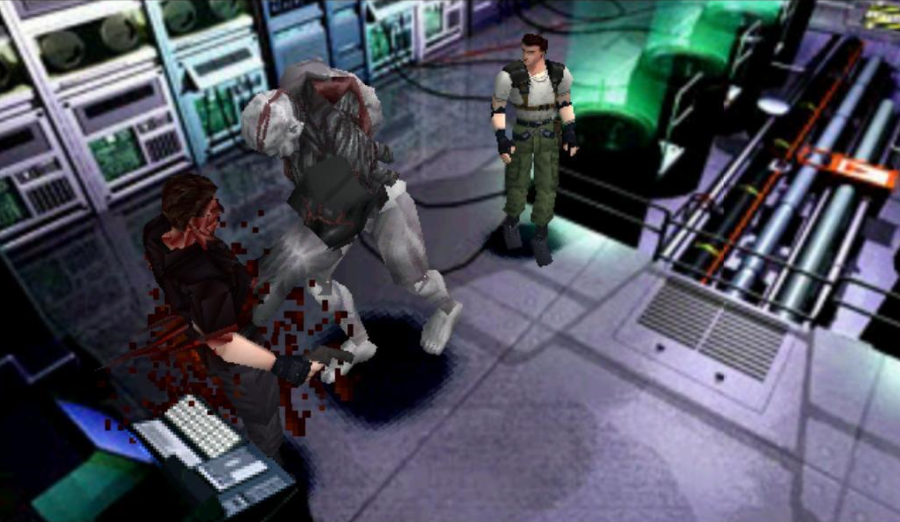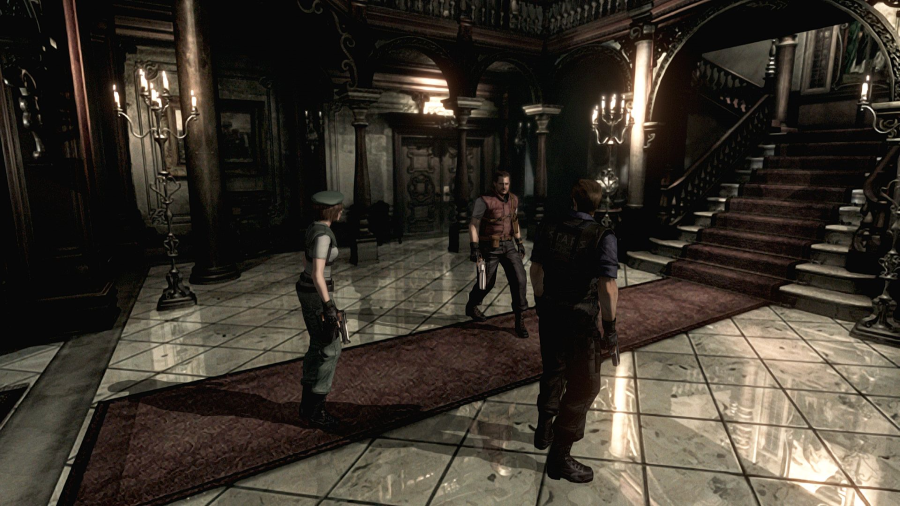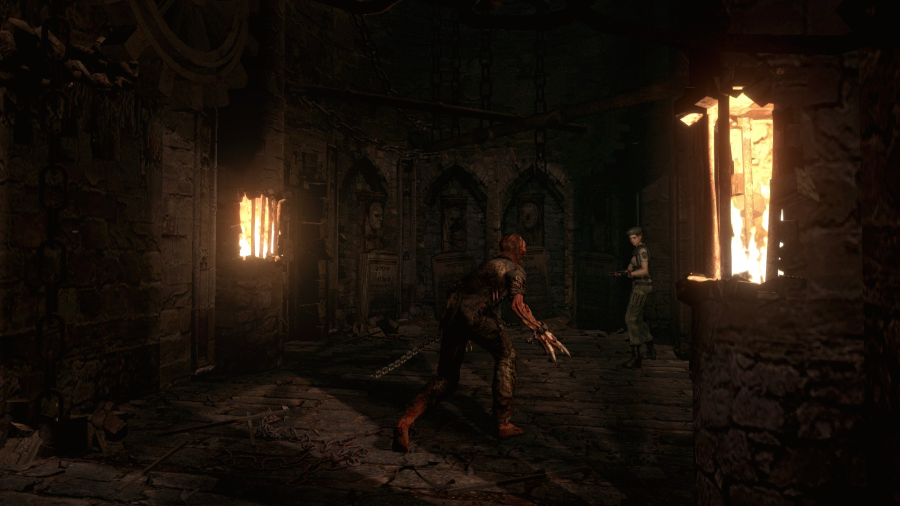RESIDENT EVIL - PART 1
Directed by Paul W.S. Anderson. 2002. United Kingdom/Germany.

Resident Evil was released by Capcom in 1996 for the Sony PlayStation. The development particulars don’t matter much here. It’s enough to say that series creator Shinji Mikami drew heavy inspiration from the zombie films of George Romero and classic PC games like Alone in the Dark. It’s the legacy and innovation of Resident Evil that matter more. Not only did Mikami’s creation give birth to a new wave of horror-infused third-person action games, it single-handedly birthed an entirely new genre of video game: survival horror.
It was a runaway success, critically and financially, selling more than two and a half million copies. The original release was followed by a so-called Director’s Cut edition in 1997 that remixed some areas and bits of soundtrack. The sequel, Resident Evil 2, was even more of a blockbuster. In terms of revenue generated, the game (also released for the Sony Playstation in 1998) outperformed the majority of Hollywood films released that year. It was with these thundering financial returns that buzz began building about the possibility of a Resident Evil film adaptation.
I. ENTER THE SURVIVAL HORROR
Resident Evil begins with news of a strange rash of cannibalistic murders in the Arklay Mountains area just outside of Racoon City. The Special Tactics and Rescue Service (codenamed S.T.A.R.S) is sent to investigate. When the S.T.A.R.S. Bravo Team goes missing, the Alpha Team is called in. Led by Captain Albert Wesker, the Alpha Team lands by helicopter and quickly discovers the remains of their fallen squad members. Before they know it, Alpha Team comes under attack by a vicious pack of what appears to be diseased dogs. They run for their lives, losing members in the process. In the distance, they spot a large abandoned mansion. The remaining Alpha Team members rush inside and the game begins.
Resident Evil presents its players with a choice right off the bat. You can choose to play as Chris Redfield or Jill Valentine. Who the player chooses determines certain elements of the story as the game goes along. If you play as Chris, Jill will be missing by the time you reach the mansion. Play as Jill and Chris will be missing. Jill will frequently encounter fellow Alpha Team member Barry Burton through her side of the narrative. Chris will come across Rebecca Chambers, the only remaining member of Bravo Team. Other than these slight differences, both narratives play out the same.
It becomes apparent rather quickly that something unnatural is going on. After a brief jaunt through a dining room, the player character is introduced to the zombies roaming the corridors. Pressing further into the mansion, you discover this isn’t just an abandoned building. It’s a puzzle box with numerous traps, locked doors, environmental puzzles, and cryptic riddles. Slowly but surely, the characters learn that the mansion is just a front for a massive underground laboratory owned and operated by the Umbrella Corporation, a pharmaceutical company that is secretly developing bioorganic and viral weaponry.
You’ll encounter plenty of those bioweapons during your playthrough. A giant snake slithers around in an attic. A bloodsucking, sentient plant has grown inside one of the dormitories. Massive spiders, undead dogs, and mutant sharks round out the cast of semi-natural dangers but the real threat lies in the true bioweapons. Bipedal reptiles called hunters chase Chris and Jill through narrow hallways. In the labs below, the deadly insectoid chimera search for fresh victims.
The player character eventually discovers the full truth of the situation. An experimental virus known as the T-Virus was accidentally unleashed inside the labs. In the ensuing chaos, the bioweapons escaped, some making their way into the close-by mountain ranges. In an attempt to test the effectiveness of their newly created monsters, Umbrella has S.T.A.R.S. sent to the mansion. It’s been a set-up this whole time, orchestrated by a faceless, evil company whose tendrils reach deep inside the political institutions of Racoon City. Worse, Wesker, your trusted team leader, is revealed to be an Umbrella operative. Seeing an opportunity to make a large sum of money, Wesker has been planning on stealing the T-Virus for himself. For that to happen, the player character must die so Wesker unleashes one final terror: the Tyrant, a towering humanoid monster capable of rending flesh from bone with terrible ease.
Unfortunately for Wesker, the Tyrant doesn’t play nice with anyone regardless of their allegiances. Wesker is seemingly killed by the bioweapon and the player must defeat the monster before the whole facility self-destructs. The game ends with the remaining S.T.A.R.S. members (how well the player performed will determine who survives to the closing credits) flying away in a helicopter as the mansion disappears in a fiery explosion.
II. ITCHY TASTY - SURVIVING THE HORROR
It’s easy to see why Resident Evil would be earmarked for a film adaptation. It has virtually everything you would want from an action-horror hybrid. Zombies, mutants, monsters, a nice visual dichotomy of the rotting wood of the mansion and the clean tiles of a state-of-the-art laboratory, espionage, conspiracy… it has it all.
These days, we tend to look back on the classic Resident Evil for the PlayStation and remember the poor localization. Resident Evil was not planned as a blockbuster. Capcom, the company behind the title, didn’t expect sales to be through the roof for months on end. As a result, very little effort was put into the US and UK localization process. The English language script was an inaccurate and botched translation. The dialogue was recorded in a rush by actors clearly thinking they were recording dialogue for a cartoonish, over-the-top cheese-fest. But Resident Evil is not that at all and the hammy, corny dialogue rubs abrasively against the grim and gory gameplay.

Thankfully, cut scenes are few and far between. The majority of the gameplay involves creeping through claustrophobic environments while managing a short supply of ammunition and healing items. The central conceit of survival horror is that resource management is sharing an uncomfortable living space with typical video game empowerment fantasies. You ARE a badass in Resident Evil regardless of who you choose to play as but the game seldom lets you act like one. There are far more zombies and critters in the mansion and laboratory settings than you have ammunition to deal with. As a result, dodging enemies and carefully planning routes through the environment are key.
You have a very limited inventory capacity with every item (even something simple like a key) taking up one full slot. Save rooms grant you access to storage chests but those save rooms usually lie on the edges of the map which means simply dropping off an item will inevitably put you in harm’s way. The mansion and laboratory environments are full of puzzles that usually require a key item to complete like a crest or a lever. Your first time through the game, you won’t know where or when you’ll need those items. So the game presents you with a dilemma. Take those items with you and possibly not have room for bullets and health sprays or risk leaving those key items behind only to find out you need one of them to progress further, thus necessitating a slow and dangerous walk back to the item storage room.
This is the essence of survival horror. Even saving your game in Resident Evil is a gamble that needs to be carefully thought through. Your ability to save is tied to a consumable item. Run out of that item and you’re screwed. But not saving after an hour of progress means risking losing that hour of progress if your ability to dodge zombie bites goes out the window. Every movement needs to be calculated because every mistake has serious consequences.
These are not elements that can be translated easily (if at all) into a film so when talk of a Resident Evil adaptation started growing in volume, many devoted fans of the franchise found themselves asking “how exactly does one make an accurate adaptation of a game like this?”.
III. GEORGE ROMERO’S RESIDENT EVIL
Romero had recently directed a commercial for the Japanese release of Resident Evil 2. Though a direct sequel to the first game, neither Jill nor Chris would be featured. It would instead focus on Leon Kennedy, a rookie police officer whose first day on the job just so happens to coincide with the full-scale outbreak of the T-Virus, and Claire Redfield, Chris’s little sister. Again, both characters would have their own separate storyline sharing similar environments, each with unique side characters and lore-expanding revelations regarding Umbrella.
Larger in scope, Resident Evil 2 was more DAWN OF THE DEAD than NIGHT OF THE LIVING DEAD. Thanks to its massive appeal and record-breaking sales, it was assumed by some that whatever adaptation would be made of the franchise, it would start here, skipping the events of the first game. But no, Capcom was determined to start the film franchise at ground zero and who better to approach than the man whose films inspired their newly minted cash cow franchise.

George Romero was contracted to deliver a script. Not knowing a thing about video games, Romero watched as someone played the game for him, taking notes all the while. What he eventually produced was a script that came fairly close to a one-to-one translation. Almost everything is there. The giant snake, the sharks, the hunters, the Alpha Team, the Tyrant, and its rocket launcher induced demise. The changes were largely to the characters. Chris was no longer a S.T.A.R.S. operative. He was changed into a Native American rancher whose horses were among the creatures attacked by the batch of escaped bioweapons. Moreover, he was a love interest for Jill, the new lead of the film. He was an everyman, an audience surrogate.
This script has been available online for many years now. It’s an enjoyable read, filled with hamfisted Romero dialogue and more than enough eviscerations to please any zombie film fan. Would it make for a good film? Definitely not. But we wouldn’t have to worry about that. It was clear from the get-go that this script would require a great deal of money to get made properly. Rendering giant monsters using simple polygons was one thing. Large-scale animatronics or costly CGI was another. As a result, Romero’s script was passed on.
Cue Paul W.S. Anderson.
IV. THE HOWS AND WHYS OF VIDEO GAME ADAPTATIONS
Anderson’s screenplay was not originally a Resident Evil adaptation. It was a Resident Evil rip-off, a fact he doesn’t try to hide. How exactly the script was retrofitted into a Resident Evil film is beyond me, but the fact remains that in terms of changes made to the source material, Anderson’s script goes way past anything Romero attempted.
Once again, it would prove to be too expensive for the moneymen at Sony Pictures and that appeared to be that. But the German arm of the production, Constantin Films, didn’t want to let the project go. With help from Columbia TriStar, Anderson’s screenplay would finally find a green light. The cost of production was somewhere in the neighborhood of 40 million dollars, a princely sum for what Sony Pictures thought was just a throwaway horror property.
Anderson was vocal about his intentions, eager to make a film that would not be considered a simple movie tie-in. Gone were the S.T.A.R.S. team. The snake, the spiders, the chimera, the Tyrant, the hunters… all gone. The zombies and undead dogs would make appearances (along with a creature lifted from Resident Evil 2) but that’s it. Resident Evil’s stable of memorable beasties was whittled down to just two holdovers.
Umbrella was no longer a shadowy, shady corporation operating behind the scenes. They were front and center right from the start. Instead of a slowly unraveling mystery, we would be given buckets of exposition from a newly created sentient AI given the form of a child. There would be a duplicitous backstabber in the group, but their actions would have little impact on the narrative, let alone the characters. Most importantly, the horror would be largely excised and replaced with gunfire and chases.
This was not Resident Evil the video game. This would be RESIDENT EVIL the movie.
Video games have been given the short end of the stick when it comes to adaptations. Few, if any, get it right. Ironically enough, Anderson came close with his 1995 adaptation of Midway’s popular fighting game Mortal Kombat. In tone, it’s fairly close to the game. Most of the popular characters make an appearance and behave like their digital counterparts. But Mortal Kombat, the video game whose bloody fisticuffs and disembodied spines helped ignite a long fight against violent digital entertainment, was unceremoniously neutered by New Line Cinema and released with a PG-13 rating to cash in on teenage ticket buyers.

Because when it comes to adapting video games, the narrative (if there is any) doesn’t matter. The characters, unless their name is in the title, don’t matter either. What matters is the general premise and the title. That’s where the money lies.
Now some of that comes down to the difficulty in adapting something which works wonderfully in a single medium into something that… well, can’t really work in any other medium. Imagine what an adaptation of The Legend of Zelda would look like. How many changes would need to be made for that to work? Your silent, solo protagonist would need to speak and need to be paired with someone else at all times if only to avoid the doldrums of a single character film where the lead never utters a word. Imagine BioShock as a film. How would that work? Jack would need to talk. Jack would need agency in a game that is purposefully about Jack’s lack of agency.
If BioShock were ever adapted, we certainly would have Rapture and Andrew Ryan. We may even get Atlas and Tenenbaum, but we wouldn’t get BIOSHOCK. Because what makes BioShock BIOSHOCK is all the little moments of quiet exploration. The tension of fighting a small army of splicers or trying to take down a Big Daddy with just a sliver of health and a pocket of ammunition. It’s how the world seems bigger the more you look at it. It’s about the side stories the environment paints along the way.
Video games are about the moment-to-moment gameplay. John Carmack once said that stories in video games are like stories in pornos. We expect them to be there but they don’t matter. That’s not necessarily true for all games but it IS true for most of them. Because a game is something you play far more than it is a narrative you experience. When done well, a good video game will feed you a narrative without you even knowing it. Go play through System Shock and its sequel and pay attention to how the environment tells you the entire narrative without ever once bringing the gameplay to a halt. BioShock is the same way. The Legend of Zelda is the same way. It’s the marriage of gameplay and narrative that makes video games a unique medium for storytelling. The characters don’t fail. We fail the characters. That death by zombie bite that sets you back an hour in Resident Evil hurts precisely because you suffer the repercussions too.
That’s not an experience you can have with a film. Defeating the bosses in Anor Londo for the first time after failing over and over again is a rush you can’t get in a movie theater. If Dark Souls was made into a movie, the failure of the lead to defeat Ornstein and Smough in Anor Londo would be glossed over, reduced to just a temporary bump in the hero’s journey. The film would have to proceed by necessity whereas in the game you are forced to persevere or otherwise give up. You have to earn the right to see the rest of the story play out. You are active in the development of the narrative instead of passively experiencing it.
Anderson’s decision to jettison nearly everything Resident Evil about his RESIDENT EVIL adaptation shows both a total lack of care about the source material and an understanding of the difficulties in making the transition from television screen to movie screen work. It’s an unenviable task but one that can’t really be avoided. Romero chopped out all the puzzle work and key fetching from the game. He gave his adaptation a game-like structure with each chunk of narrative punctuated by a boss fight of sorts. It felt like a game, not like a movie.
Anderson’s film feels like a proper film. It has easily definable acts. Characters have easily identified arcs. Everything is constructed properly in terms of structure. It is a film first and an adaptation second.
But that raises a question… With no characters carried over from the video game and very little in the way of direct visual or narrative inspiration taken from the source material, is Anderson’s RESIDENT EVIL actually an adaptation, or is it still just a rip-off?